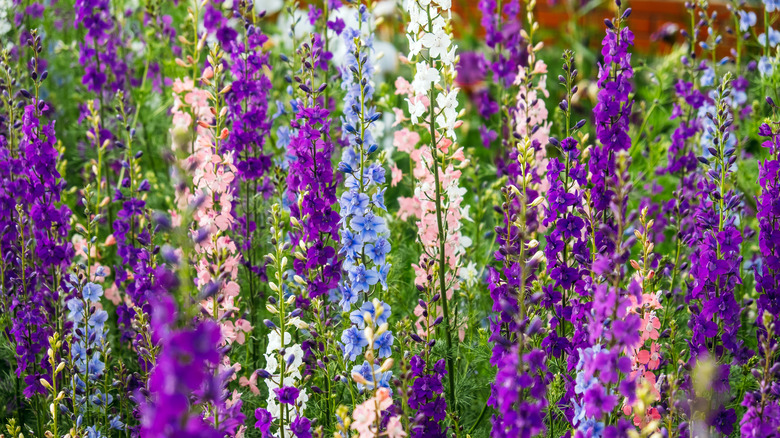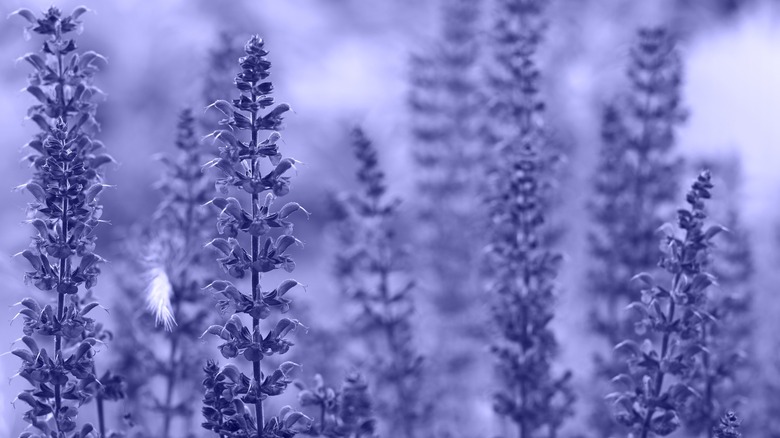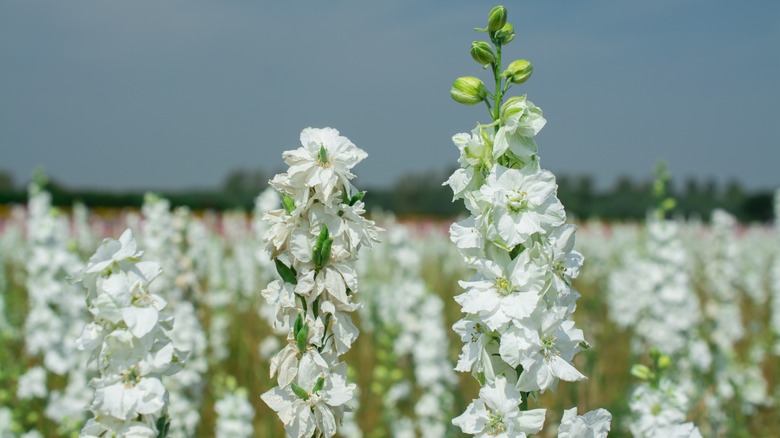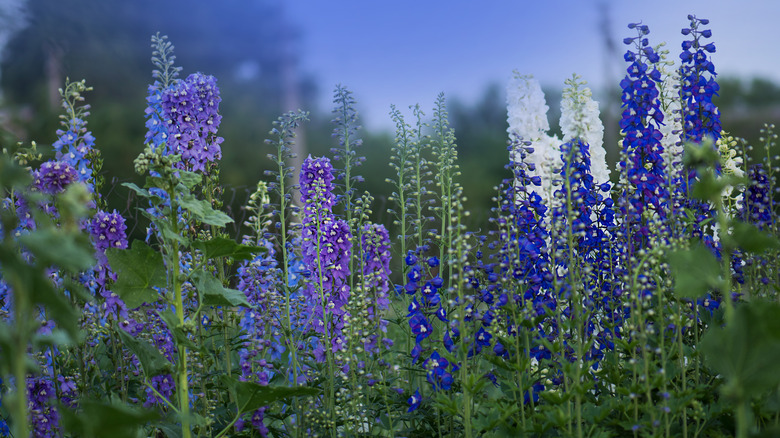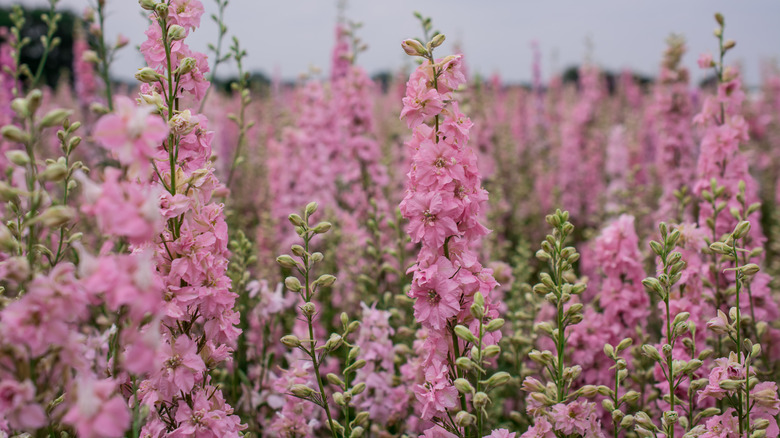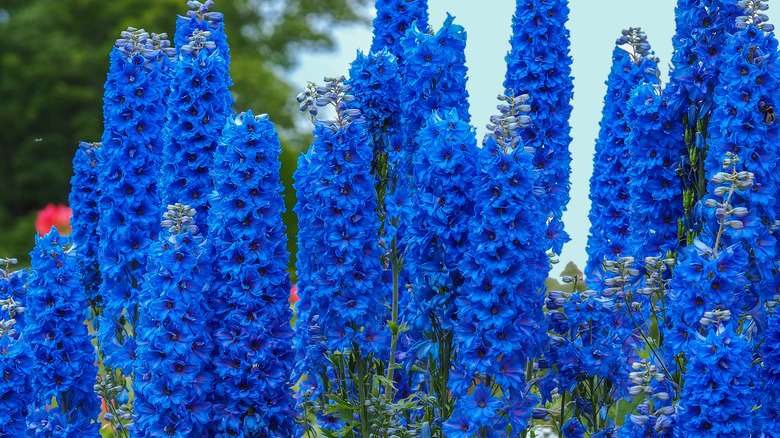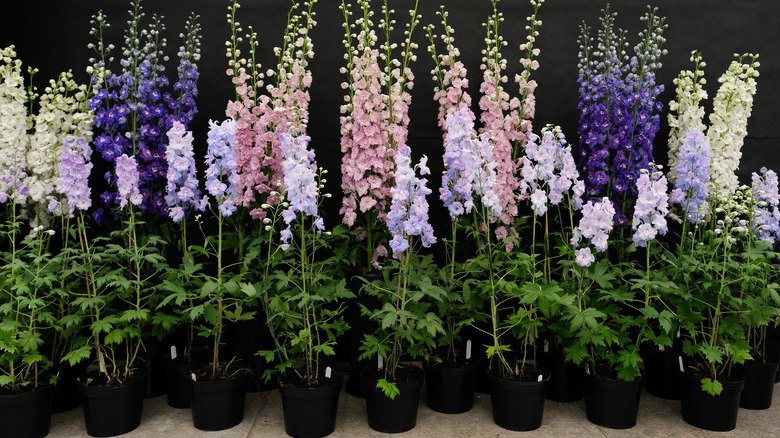How To Grow And Take Care Of Delphiniums
Delphiniums, also commonly referred to as larkspurs, can be found in both annual and perennial varieties. The flowers get their names from the Greek word for dolphin, "delphis," according to Florgeous, because the individual petals resemble the aquatic mammal. The flowers are also a part of the buttercup family.
In flower language, delphiniums symbolize joy and happiness, as well as positive communication and protection against negative or evil spirits, said Petal Republic. More specifically, blue delphiniums symbolize grace, dignity, youth, and success. Purple delphiniums represent royalty and beauty. White delphiniums symbolize purity, innocence, and spirituality (and are often gifted at weddings, baptisms, and for newborns). Finally, ink delphiniums represent love, romance, and new life.
According to Greek mythology, delphiniums blossomed from the blood of the Trojan war hero and Greek god Ajax after his death (via Victoria Whitelaw). Delphiniums are gorgeous spike-shaped flowers that come in an array of colors and sizes and most commonly bloom in the spring or summer, making them a great addition to any flower garden.
How to use delphiniums in garden
Delphiniums are gorgeous stand-alone flowers, but they also add a lot of visual intrigue to any landscaping project. There are a few things to consider before planning out a stunning flower garden with delphiniums, though. First, decide what type of delphinium variety you want. More than just the appearance of the variety, make sure you know if it's an annual or perennial. Annuals will bloom longer but die off during the winter and won't regrow. Perennials will have a shorter bloom period but come back every year. Also, ensure you're in the correct hardiness zone. According to Better Homes & Gardens, delphiniums are equipped to grow in USDA hardiness zones 3 to 7. They can grow in other climates, but likely only in pots.
Delphiniums offer plenty of benefits to a garden. For one, they're deer resistant, per Gardening Know How. Consider using them to border other plants or crops that deer may be interested in. Also, while they attract Japanese beetle bugs, they typically die upon ingesting delphinium petals.
Delphiniums benefit from a variety of companion plants. Some common problems the flowers face are harsh winds or rainfalls stripping them of their petals. Consider planting tall grasses, sunflowers, and other wind-resistant plants around them for protection. Plants such as chamomile, French parsley, and legumes can also help provide additional nutrients to delphiniums when planted nearby. They're also compatible with roses, peonies, irises, daylilies, asters, and chrysanthemums.
How to grow delphiniums
Delphiniums can be found during their growing season at most garden centers in nursery pots, which can easily be planted in the ground or in a container. Delphiniums can also be grown from seeds, as long as you plan ahead. According to Burpee, delphinium seeds can be sown indoors and transplanted outside or planted directly into the ground in the summer.
If you want to sow the seeds indoors, do so 8 to 10 weeks before the last frost of the spring season. Using basic soil, or one formulated for sowing seeds, press the seeds 1/8 of an inch deep. Keep the seeds at 70 degrees and consistently moist, and you should start to see seedlings emerge in three to four weeks. Once the seedlings emerge, keep them exposed to bright light for 16 hours a day, either next to a sunny window or under a grow light. After about three weeks, introduce a fertilizer composed of half water and half indoor plant food. Once there are a solid few leaves, harden off the plant by moving the pots outside and sheltering them there for a week. Then, transplant to the ground after the threat of frost is gone.
To sow directly in the ground, prepare the soil in mid to late summer, and place the seeds 1/8 of an inch deep. Keep moist and ensure they're exposed to direct sun or partial shade, and expect seedlings in three to four weeks.
How to care for delphiniums
Delphiniums are relatively easy to care for and maintain in their preferred climates. Warmer zones may have more difficulty sustaining the plant than their milder counterparts, but the flowers' needs are the same nonetheless. Starting with soil, delphiniums prefer a more alkaline, humus-rich soil, according to Garden Design. While delphiniums prefer to be moist and will benefit from mulching (though not too close to the base of the plant), ensure the soil is well-draining. They will benefit from fertilization every two to three weeks, preferably a slow-release liquid blend.
Delphiniums like to be moist but don't like sitting in standing water. Therefore, average rainfall should be plenty, but water the flowers at the base in longer periods without rain, avoiding the flowers. As for sun, these flowers need six to eight hours of direct exposure a day, preferably morning and afternoon sun.
Delphiniums grow to be quite tall and will also require stakes to support the weight of the flower. Without staking, delphiniums are at risk of snapping in half from wind gusts or heavy rainfall. Attach a stake to the plant's stem at about 12 to 18 inches.
Delphinium varieties
There are over 400 varieties of delphiniums, per Garden Lovers Club. The flowers come in different colors and sizes. When planted together, they can create a beautiful, diversified scene. Here are just a few of those varieties:
- Delphinium "Highlander Blueberry Pie": This variety gets its name from the flower petal's light blue trim, purple middle, and white interior and also offers a rounder petal shape than other varieties.
- Delphinium "Guardian Lavender": This variety's light blue and lavender petals are known to attract butterflies and hummingbirds.
- Delphinium "Astolat Group": This is one of the taller delphinium varieties, growing up to 6 feet tall, and boasts muted, dusty purple or pink-colored flowers.
- Delphinium "Jill Curley": This white variety of delphinium is unmissable when matured, standing up to 7 feet tall and 3 inches wide.
- Delphinium "Blue Lace": This delphinium is unique for its two-toned flowers — the top flower is a light purple or pink, with the bottom blue flower cupping the top like lace.
Are delphiniums toxic?
Despite their beauty and versatility in your garden, delphiniums are toxic both to humans and pets. According to the ASPCA, the quality in delphiniums that is toxic to dogs, cats, and horses is called diterpene alkaloids. Symptoms of poisoning vary depending on the season and other conditions (older plants tend to be less toxic, for example). General symptoms include neuromuscular paralysis, constipation, salivation, tremors, weakness, stiffness, convulsions, cardiac failure, and even death from respiratory paralysis. Immediately call your veterinarian if you suspect your pet has consumed delphinium and is displaying symptoms, and consider taking a piece of the plant with you so the veterinarian can fully assess the situation.
The plant is also poisonous to humans. According to Flower Patch Farmhouse, ingestion of the seeds or plants can lead to severe illness, paralysis, and death. That being said, the biggest concern for delphiniums isn't for humans. While the plants are a cause for concern amongst common domestic pets, they are also a major cause of cattle death, according to the USDA Agricultural Research Service. Take care to plant the flowers away from livestock, house pets, and out of reach of children.
How to repot delphiniums
Growing delphiniums in pots is a great way for people in warmer climates to maintain the plant. And while delphiniums are often seen in sprawling cottage landscapes, keeping a potted delphinium on your balcony or front porch is a great way to display the flower's beauty with little to no garden space. That being said, larger varieties of delphinium will often grow too tall to sustain themselves in a pot or container. Dwarf varieties, however, will grow excellently in a pot.
Ensure you are repotting every two years or so. As the plant grows bigger, it will obviously need a larger pot. More than that, it is a good idea to clean off the roots and refresh the soil every two years or so, regardless of whether it needs a larger pot or not.
To repot delphiniums, begin by gently removing it from its current pot. Florists' Transworld Delivery said the key to repotting a delphinium is to keep as much of the root intact as you can. To do this, use your hands to gently break up the root system and gently massage the roots away from one another, keeping them intact and whole. Remove as much soil as possible. To your new pot, add just a little bit of soil — enough so that the plant stays at the same depth as before. Add the plant and a stake to the pot at this point if it needs one. Fill with soil and water.
